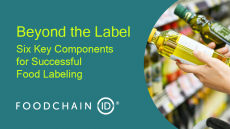FSA looks into BSE testing failures
launches an investigation into the apparent failure by the meat
hygiene arm of the food watchdog to test some casualty cattle aged
between 24 and 30 months for BSE before they entered the food
chain.
In 1992 at the peak of the BSE - bovine spongiform encephalopathy - epidemic the UK recorded 37, 000 clinical cases of BSE and about 60,000 of the highest risk animals went into the food supply, compared with less than one a year today. FSA largely attributes the significant drop in cases of BSE to the feed ban, effective in 1996, that prohibited the feeding of meat-and-bone-meal derived from mammals to all farm animals.
On the eve of the investigation in to Meat Hygiene Service (MHS), an executive agency of the FSA, the food body tried to reassure industry and consumers, claiming that any risk that might have arisen from these animals entering the food chain without having been tested 'was minimal'.
"Action has been taken to ensure that the testing requirements are now being fully met," claimed the FSA.
"This is because specified risk material controls (SRM) had been applied, which remove at least 99 per cent of any infectivity that may be present, and the fact that no cattle under 30 months have shown clinical BSE symptoms in the UK for eight years," said the FSA confidently.
The removal of SRM - including brain and spinal cord - is the main BSE control measure and according to the FSA should slice away at least 99 per cent of any BSE infectivity that may be present in cattle entering the food supply.
The FSA claims there are 'no BSE positives' in the 2,800 casualty cattle tested to date in Great Britain. The requirement to test these cattle was introduced by the European Commission in June 2001 to 'provide an early warning system of any unfavourable trend in the incidence of BSE'. Before that requirement, these cattle entered the food chain without testing although, as today, with all SRM removed.
As the UK starts to fully recover from the damaging impact of the BSE epidemic on the beef industry, in December 2003 the US government confirmed the country's first mad cow case in a Holstein dairy cow in Washington state. US officials believe the 6 1/2-year-old cow was imported into the US from Alberta, Canada, in 2001. The news sparked global bans of US beef worth an annual €3 billion in trade and a rise in organic beef sales.
A recent report from UK market analysts Organic Monitor reveals clear opportunities in the beef market with sales of organic meat products in Canada expaning by 35 per cent in 2003 mainly because of the recent BSE scare there. Many Canadian retailers reported record sales of organic beef this year due to BSE elevating consumer demand. Sales of organic beef in the US could double in 2004 if suppliers can get sufficient volume into the retail trade, claims the report.
The discovery of the first case of BSE in the US highlights the need for countries to strengthen their BSE control measures and reduce risk, the UN's Food and Agriculture Organisation (FAO) warned recently."When it comes to prevention, the situation is still confused," said the United Nations-backed body.
Reassuring a concerned consumer can only come about with better controls, more surveillance and testing, stressed the group.
"Countries that have already been exposed to BSE - for example the UK - have since applied good preventitive measures," an FAO spokesman told FoodNavigator.com at the time. Other countries also exposed to the disease - such as the Czech Republic, Japan, Israel and Poland - are coming on board, added the spokesman.
And there are many other countries that can not afford to be complacent. Essentially, the FAO believes that no country can claim to be BSE-free, unless the claim has been validated through internationally recognised survey methods, a status possible through clearance by the Office International des Epizooties (OIE) - the World Animal Health Organisation.















